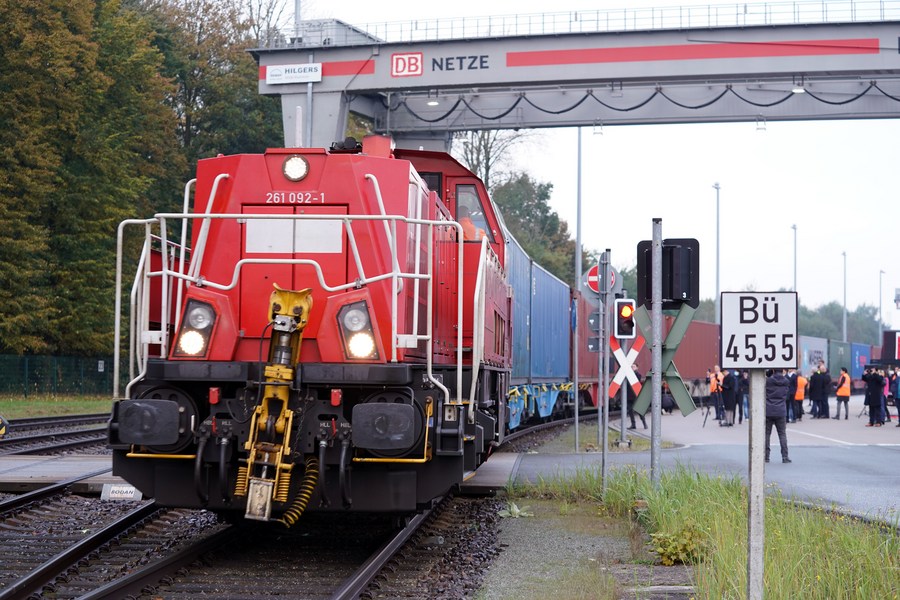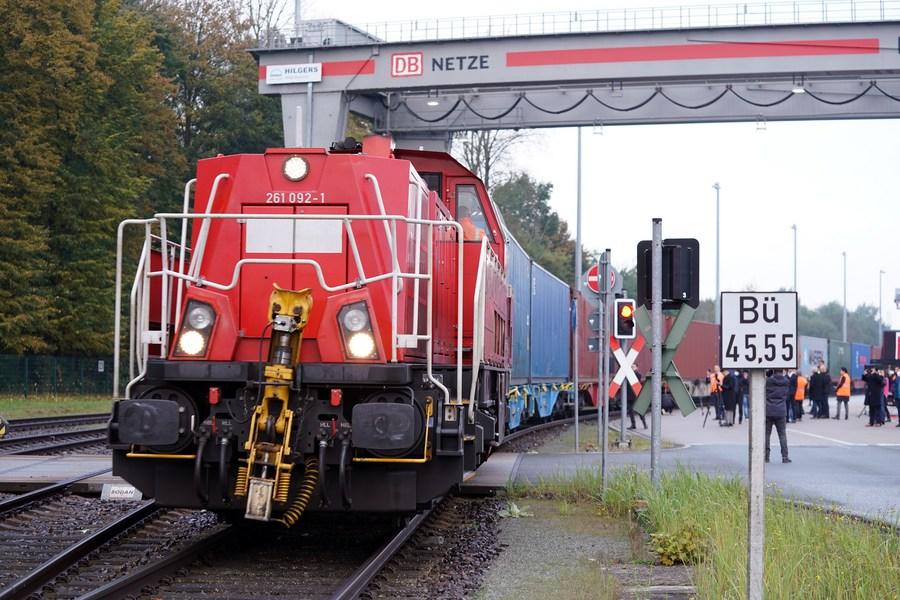BEIJING, Oct. 28 (Xinhua) -- China-Europe freight train has registered a significant increase in its trips since the outbreak of COVID-19, and become a dark horse of stabilizing global supply chains. It also helps China sustain the fast quantity growth and promote the stable quality improvement of its foreign trade.
However, the exponential growth of freight volume also poses challenges for the China-Europe freight train: increasingly insufficient capacity, worse congestion at ports, and shortage of supply of goods during the return trips.

Photo taken on Oct. 26, 2021 shows the "Shanghai Express" in Hamburg, Germany. (Xinhua/Wang Qing)
-- A rising dark horse against headwinds
Over more than ten years since its founding, AISWEI New Energy Technology (Jiangsu) Co., Ltd. has always exported goods by sea. Since July, the enterprise has transported 50 containers of photovoltaic equipment every month to Europe from Chongqing and Suzhou through the China-Europe freight train.
The China-Europe freight train has helped us overcome our immediate difficulties, a company official withAISWEI said.
Due to the impact of the pandemic, the company's containers transported by sea were stuck at the ports abroad while containers in the sea ports at home were under stress supply and usually out of stock for reservation. On account of that, coupled with decreasing shipping lines and skyrocketing sea freight fees, AISWEI instead decided to choose China-Europe freight train, a more stable and efficient channel, according to the AISWEI official.
The price of shipping a container was around 1,600 U.S. dollars at the beginning of last year, but has amounted to 4,000 U.S. dollars now. Taking the European line for example, before pandemic, the shipping price was over 2,000 U.S. dollars for a 40-foot container in domestic ports, but it is hard to reserve one shipping space even you pay 10,000 U.S. dollars, recalled Xie Yuanpeng, Deputy Manager of International Combined Transport Department of SINOTRANS Limited.
Under this circumstance, the China-Europe freight train has become the most eye-catching dark horse in the global supply chains.
According to the data from China Railway, last year, the China-Europe freight train made a total of 12,400 trips and transported 1.135 million TEUs of goods, up 50 percent and 56 percent on a year-on-year basis, respectively. In the first three quarters this year, the China-Europe freight train made a total of 11,300 trips and transported 1.093 million TEUs of goods, up 29 percent and 37 percent on a year-on-year basis, respectively.
Amid the pandemic, the biggest advantage of the China-Europe freight train lies in safety, compared with the shipment by air and sea. As introduced by Qi Dan, General Manager of YUXINOU (Chongqing) Logistics Co., Ltd., the China-Europe freight train applies a segmented transport model, in which drivers and locomotives are changed in different countries.
Besides, via the China-Europe freight train, it takes only one third of time needed by sea, but the price is the same as that. The China-Europe freight train has achieved leapfrog growth owing to its safety and efficiency.
-- Surge of freight volumes brings new challenges
However, the rapid growth of the volume of freight transport also poses a daunting challenge for the China-Europe freight train: increasingly insufficient transport capacity, worse congestion at ports, and shortage of supply of goods during the return trips.
As a large number of goods are transferred from sea transportation, the China-Europe freight train is faced with the shortage of transport capacity. It is harder to reserve its freight space. At this special moment, we have to prioritize those customers with long-term partnership, said a person in charge of one operation platform of the China-Europe freight train in China.
The backward infrastructures along the route is hard to adapt to the exponential growth of transport capacity, so the efficiency is seriously impacted due to the worsening congestion at ports.
The shortage of goods on the return trips is due to both objective reasons and subjective ones such as fewer overseas locations and insufficient market development, said Che Tanlai, Deputy Secretary-general of the Eurasian Land Bridge Logistics Branch of the China Communications and Transportation Association.
Experts and industrial insiders believe that the trouble, as a problem in the course of development, will be resolved through further development. It presents both challenges and opportunities for high-quality development of the China-Europe freight train.
-- Seize the opportunity for high-quality development
Insiders indicate that something should be done to unblock bottlenecks along the routes, make more efforts to seek return-trip goods, and further build the China-Europe freight train into a globally influential logistic supply chain.
In July last year, the National Development and Reform Commission announced that it would allocate RMB 200 million yuan to support the construction of a demonstration project for the assembly center of the China-Europe freight train in five cities, including Chengdu, Zhengzhou, Chongqing, Xi'an, and Urumqi. This will help the five major cities use their geographical advantages to integrate market resources, improve market competition mechanisms, and promote the overall high-quality development of the China-Europe freight train.
While transforming and upgrading the domestic infrastructure, we should also increase investment in foreign hubs and distribution centers, unblock bottlenecks, and improve the service and guarantee capability of the China-Europe freight train during its foreign sections.
In terms of the organization of return-trip goods, Che Tanlai suggested it is necessary to promote qualified state-owned enterprises such as China Ocean Shipping (Group) Corporation, China Foreign Trade and Transportation Corporation, and domestic freight train operating platforms to go global to set up their own operating platforms abroad, and strengthen organization capacity of return-trip goods.
(Edited by Bao Nuomin with Xinhua Silk Road, baonuomin@xinhua.org)




 A single purchase
A single purchase









